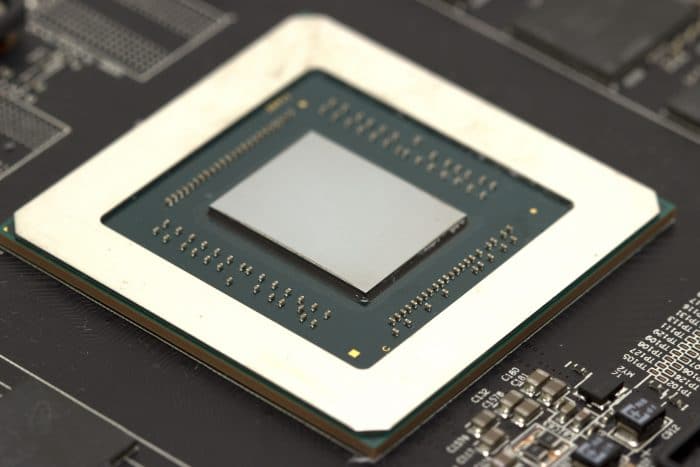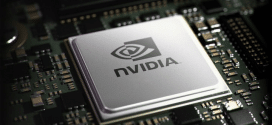What’s under all of the plastic of the Thicc II Pro?
The cooler of the RX 5600 XT Thicc II Pro is a flat mostly smooth copper cold plate with four heatpipes running across it and into the fin stack. The memory is attached to the fin stack and is copper which should be a major improvement over the other Thicc cards which came previously that had what looked like a stainless plate for memory cooling.
The PCB for the RX 5600 XT Thicc II Pro is very similar to the RX 5700 series and the only real difference I see is a large amount of plastic embellishments for the shroud.
Here we have the much smaller 7nm Navi GPU for the RX 5600 XT which is also the same GPU for the RX5700 series. This is a 7nm unit based on NAVI architecture and has proven to be a solid performer, so we are excited to see how the GPU falls in the results stack.
The memory on our card is Micron labeled D9WCW and is 14,000 MHz effective rated GDDR6. This is strange as the Thicc II Pro has a standard memory clock of 12Gbps, and that means anyone buying this card should easily be able to achieve higher performance with a quick overclock. This is, of course, pending that AMD has not pushed some arbitrary limit on memory OC via the driver or VBIOS
The power controller for the RX 5600 XT Thicc II Pro is an NCP81022 from ONSemi which is a 4+1 configuration. This matches our board analysis and the controller is running in this configuration with phases doubled, for a total of eight power stages for VGPU and two stages for VMEM.
thew power stages themselves are 45A nominal units from ONSemi as well, model number NCP302045. These are fully integrated power stages and have a peak current rating of up to 75A, but the normal operating range is up to 45A as previously mentioned.
Since I tend to take everything apart to show you guys how it works, I do feel it is pertinent to note that our sample as you can see in the image has three inductors on the VGPU VRM which are budged and cracked at the top. This can theoretically lead to eventual inductor/coil whine down the road as the internal coil vibrates with a load which is why they are potted in these encasements. These look to not be physically damaged and merely a potential either bad component choice on XFX’s part or even a bad batch of good components that XFX, unfortunately, got stuck with. We will find out soon if we see user issues cropping up.
Now that we have taken a peek behind the curtain of the RX 5600 XT Thicc II Pro, let’s see how it performs in our testing.
 Bjorn3D.com Bjorn3d.com – Satisfying Your Daily Tech Cravings Since 1996
Bjorn3D.com Bjorn3d.com – Satisfying Your Daily Tech Cravings Since 1996














